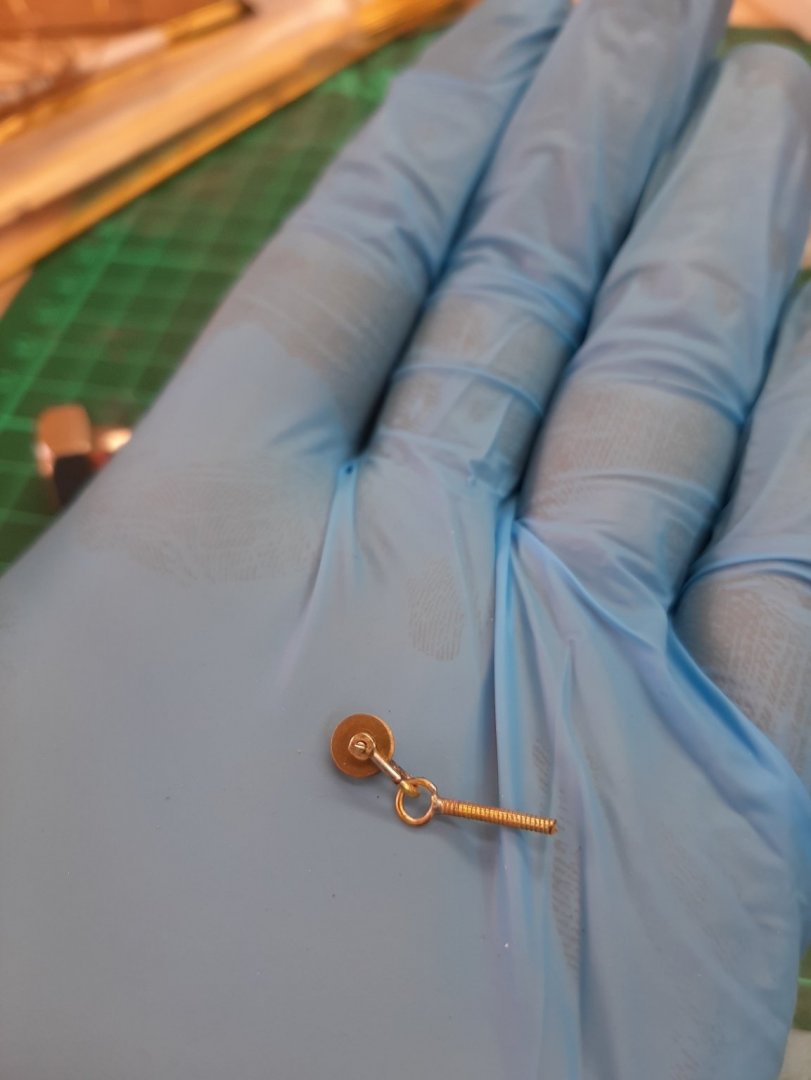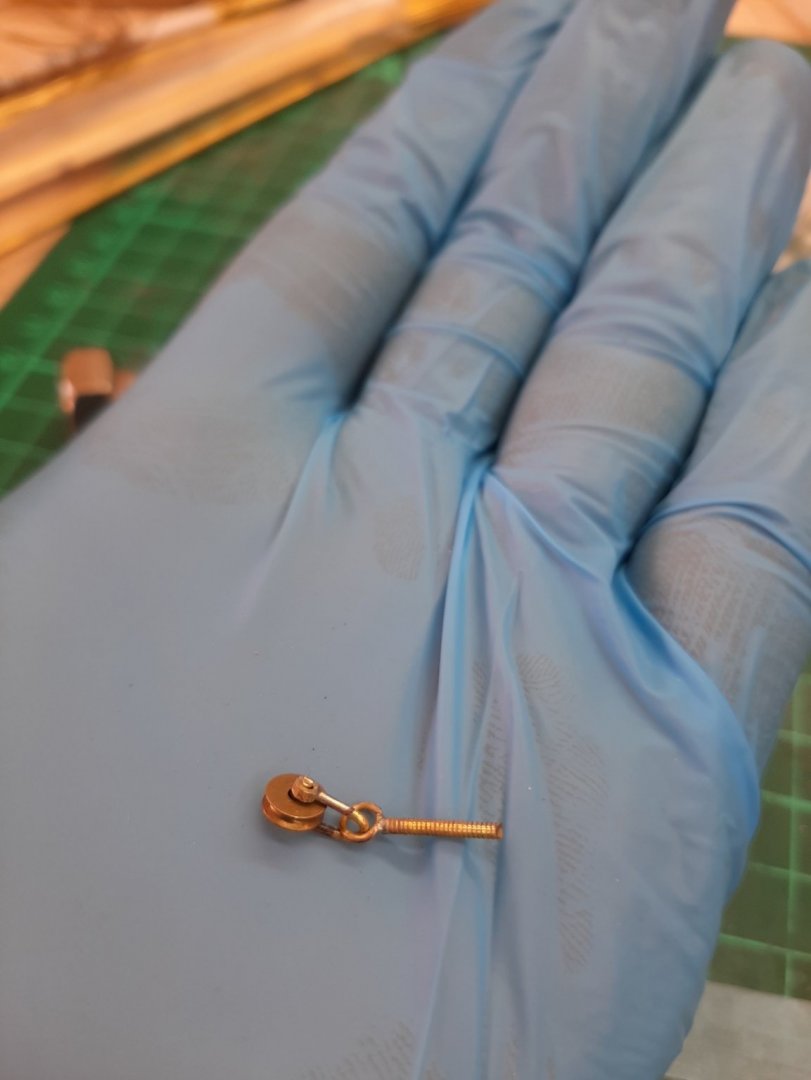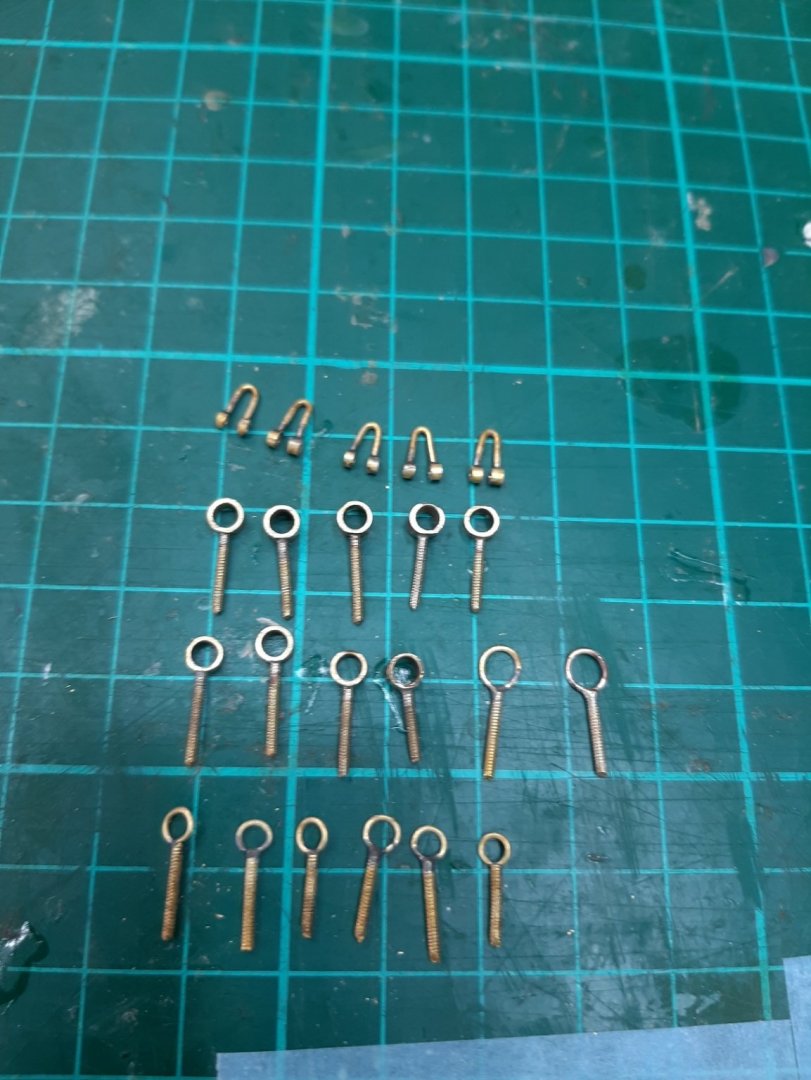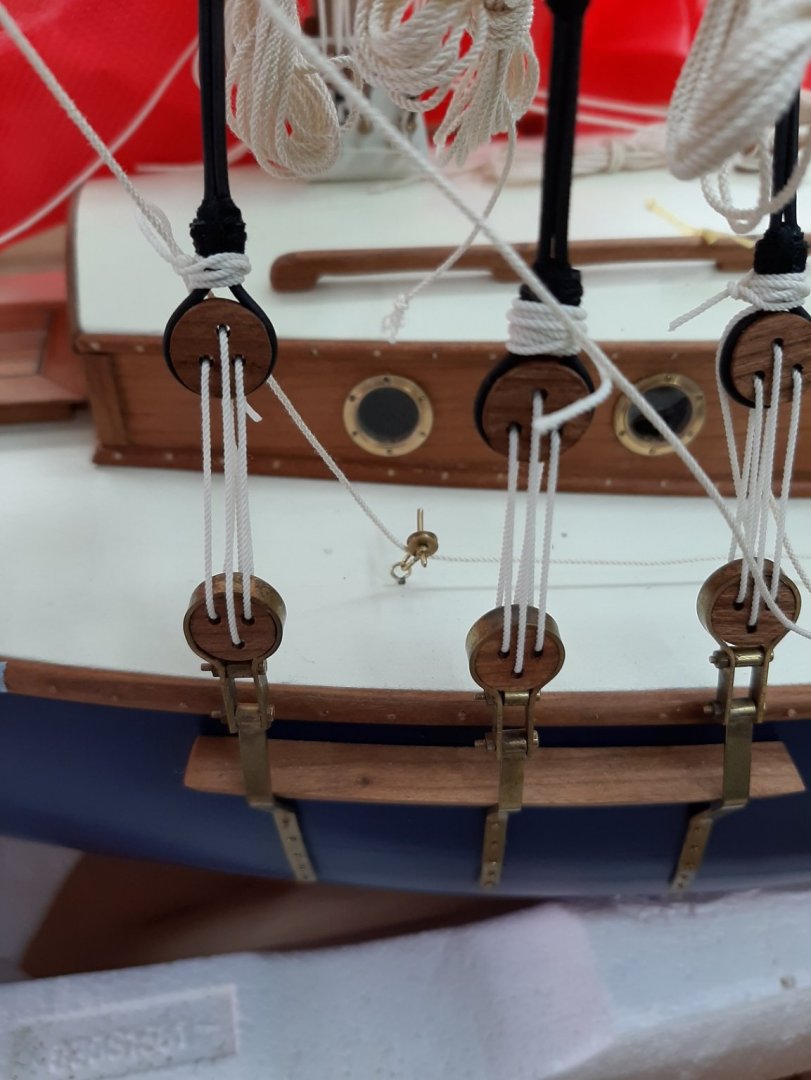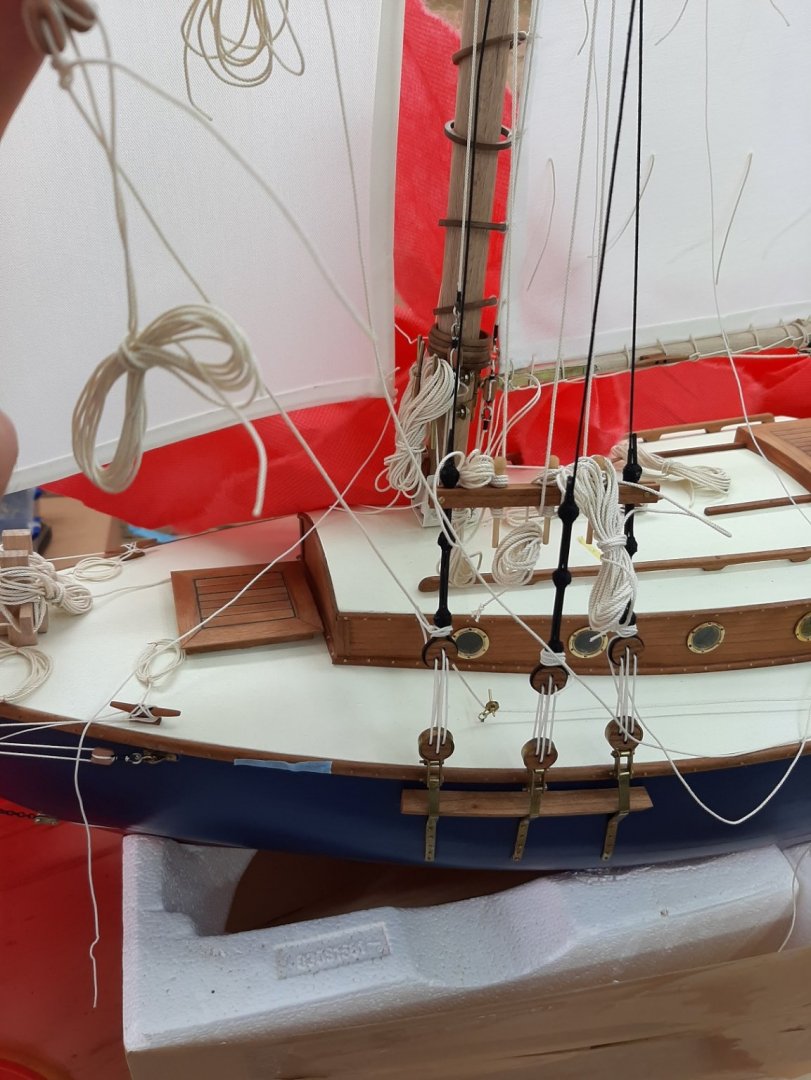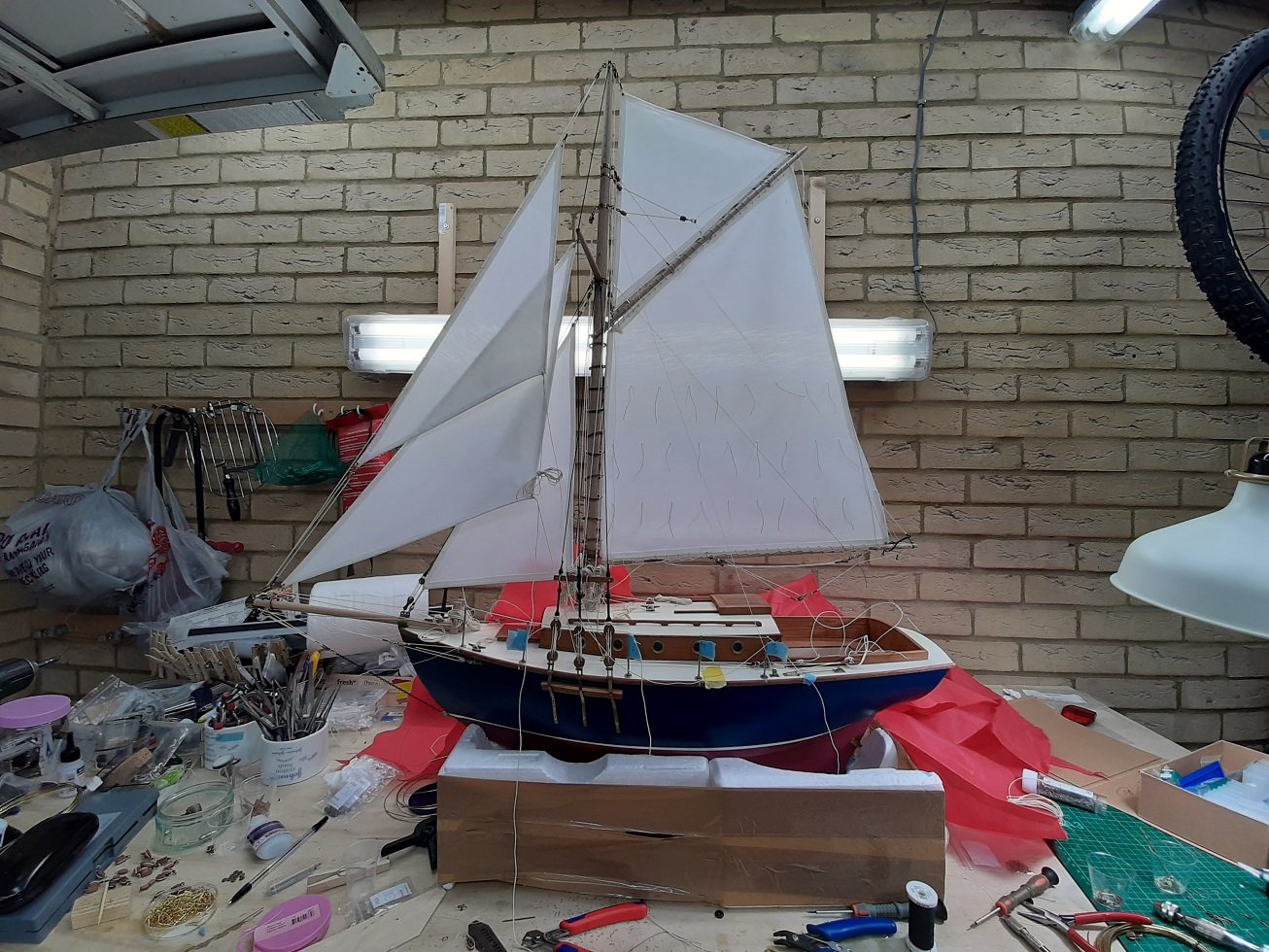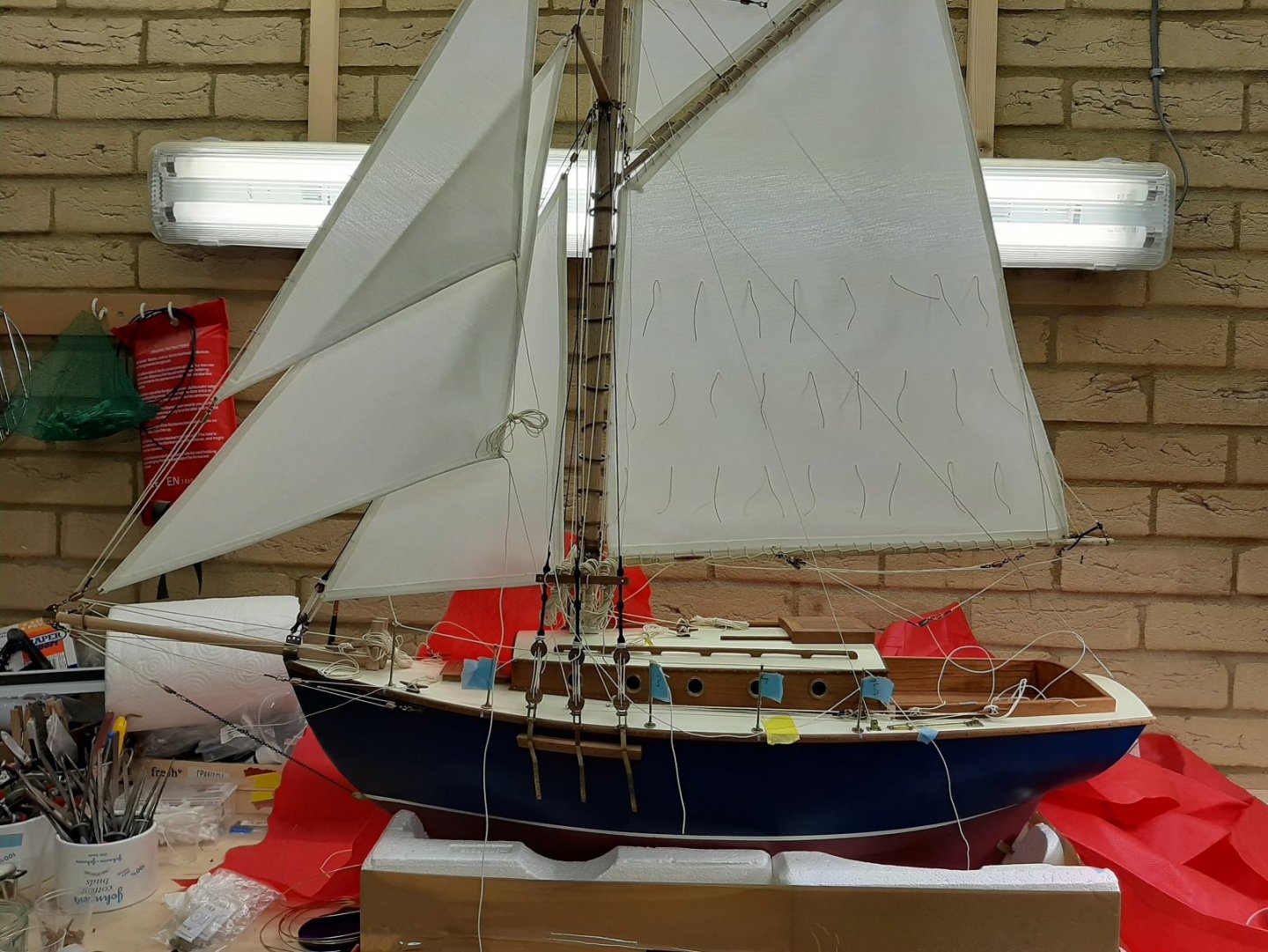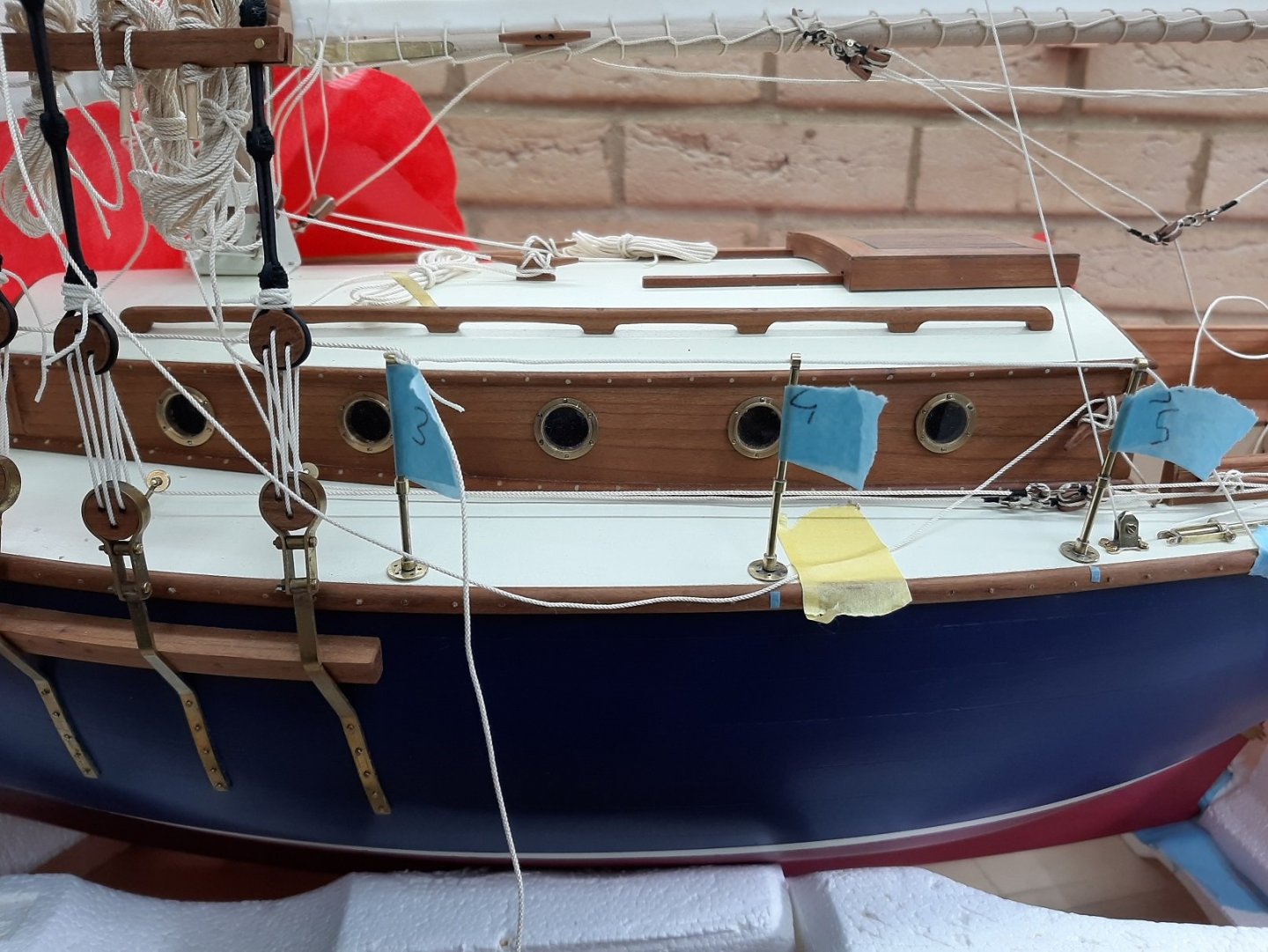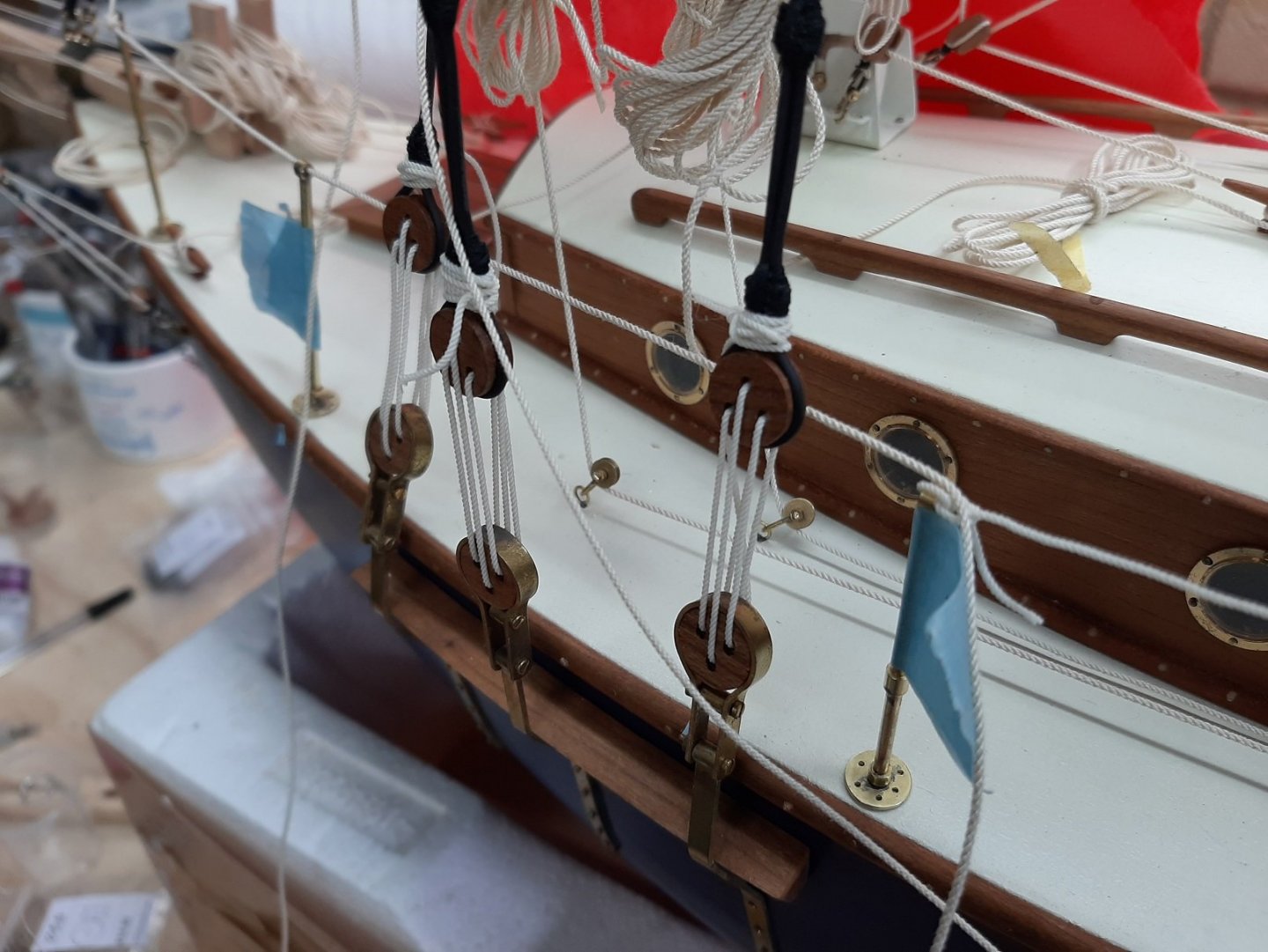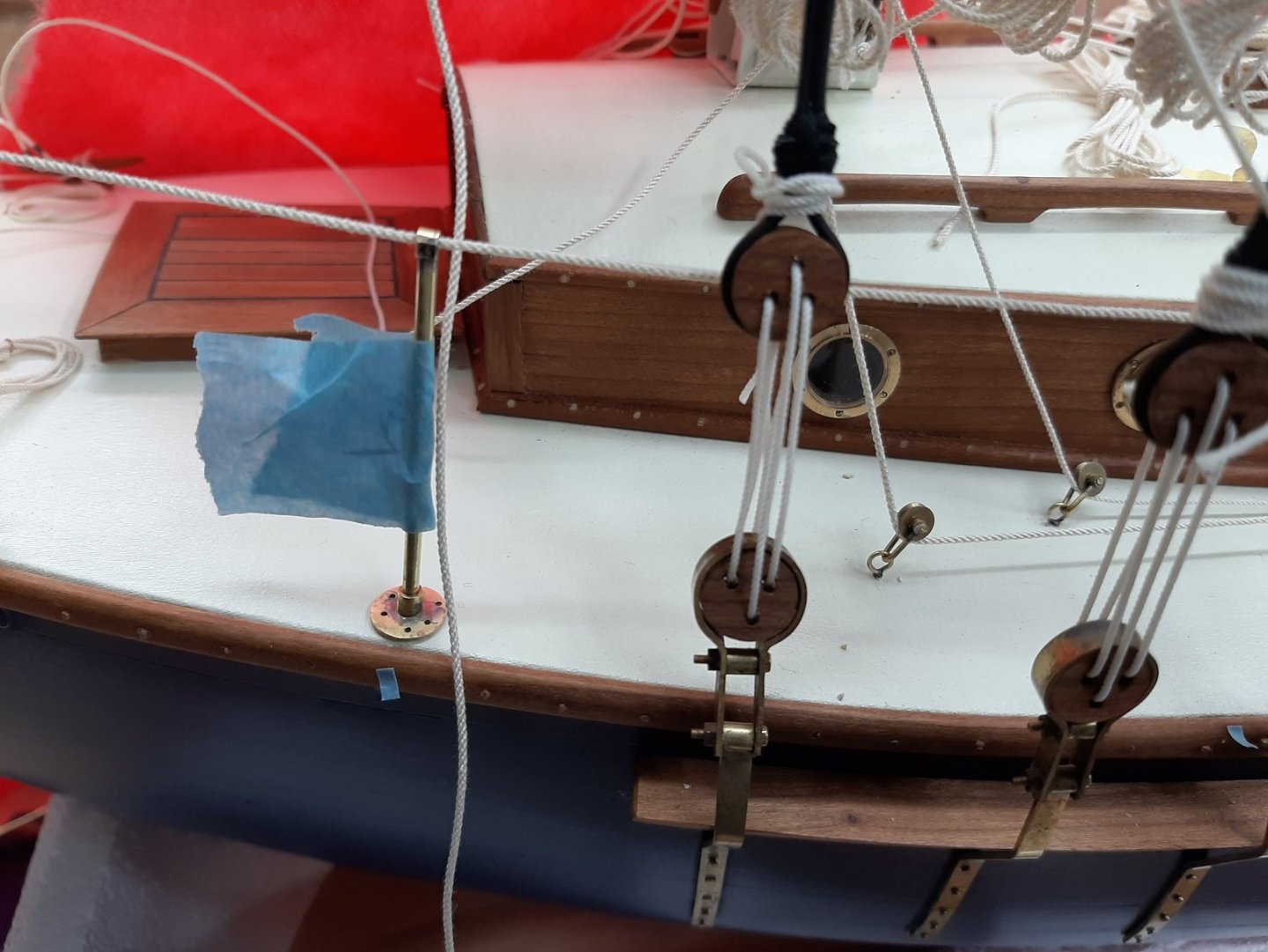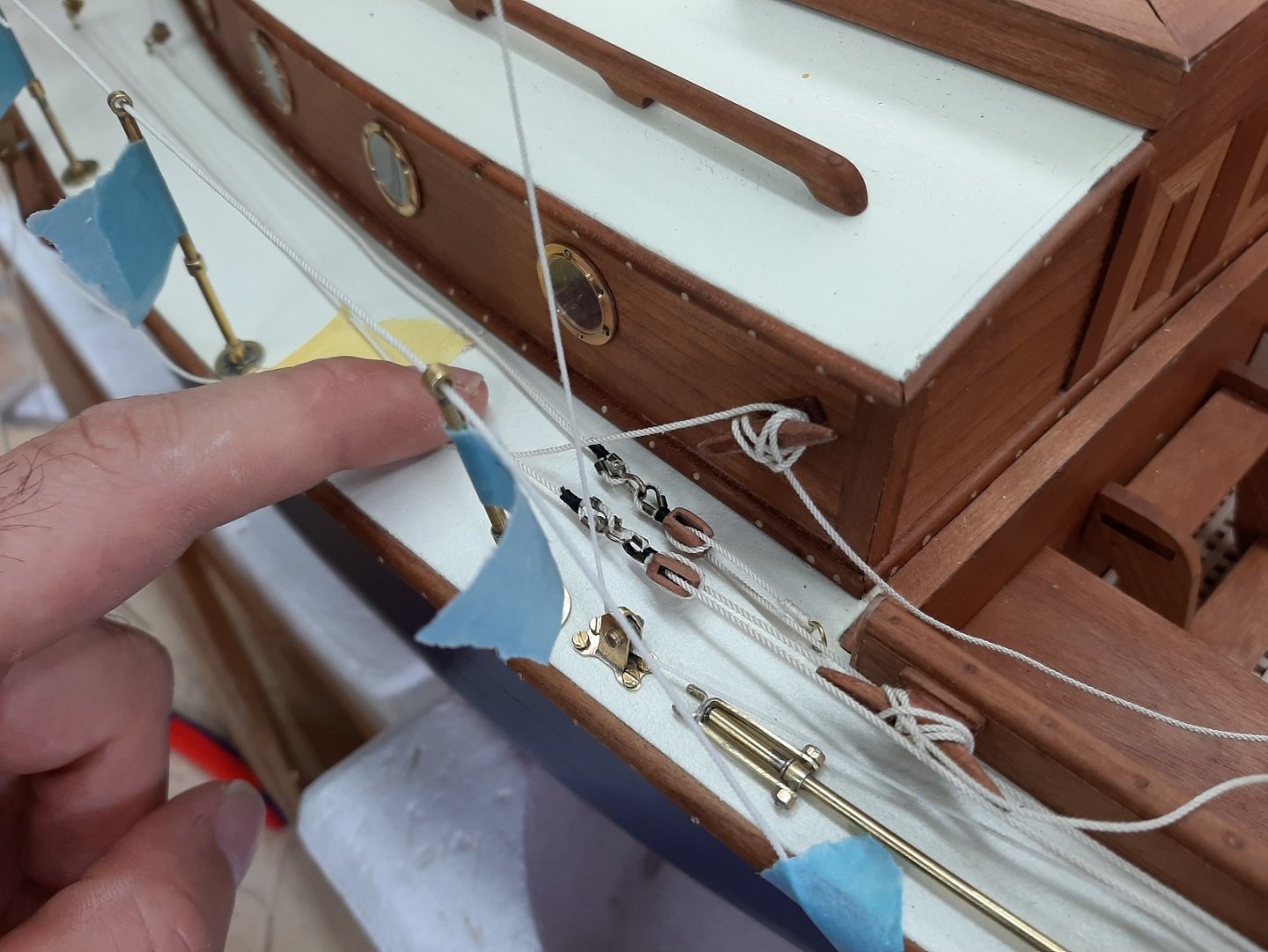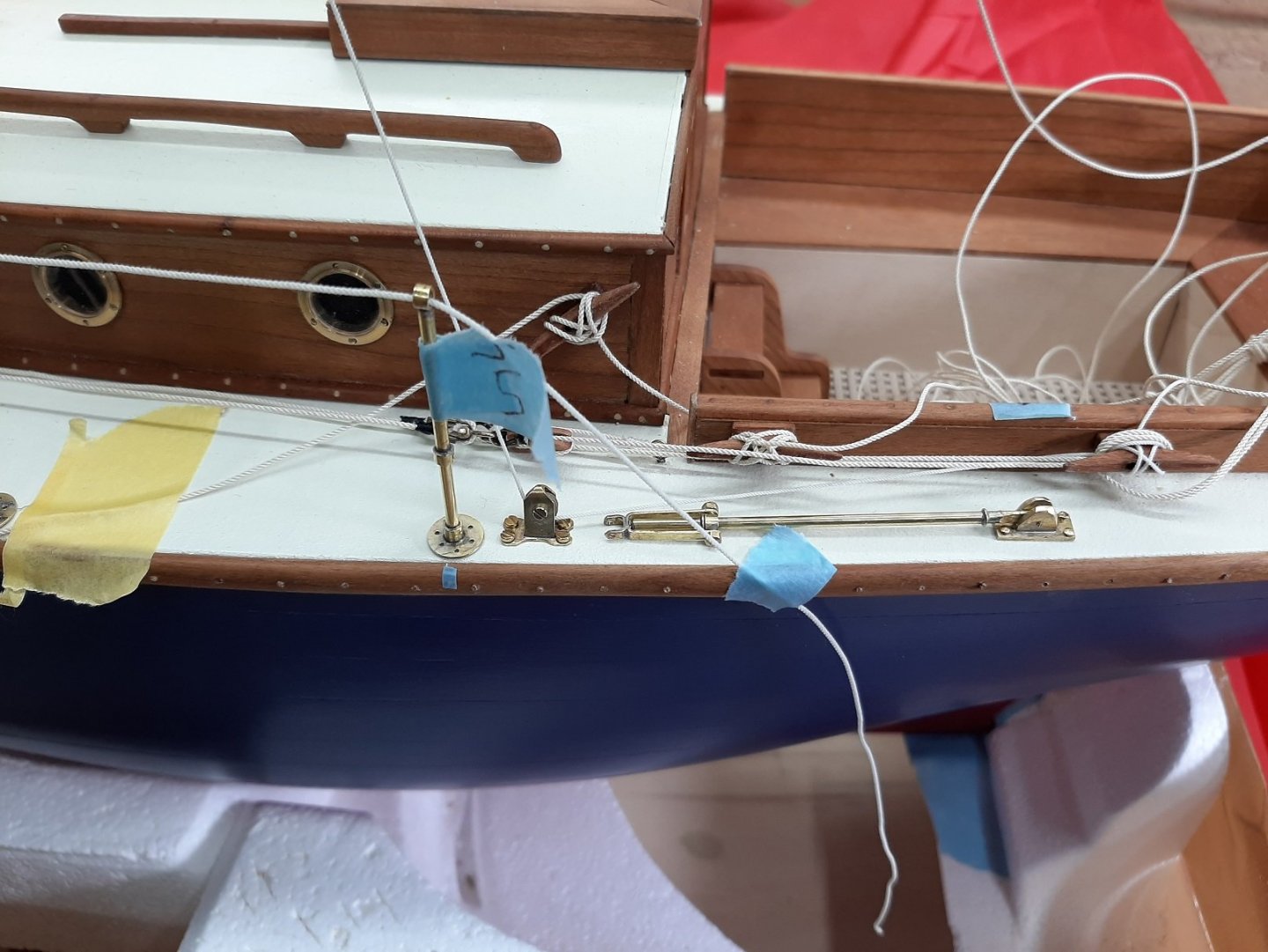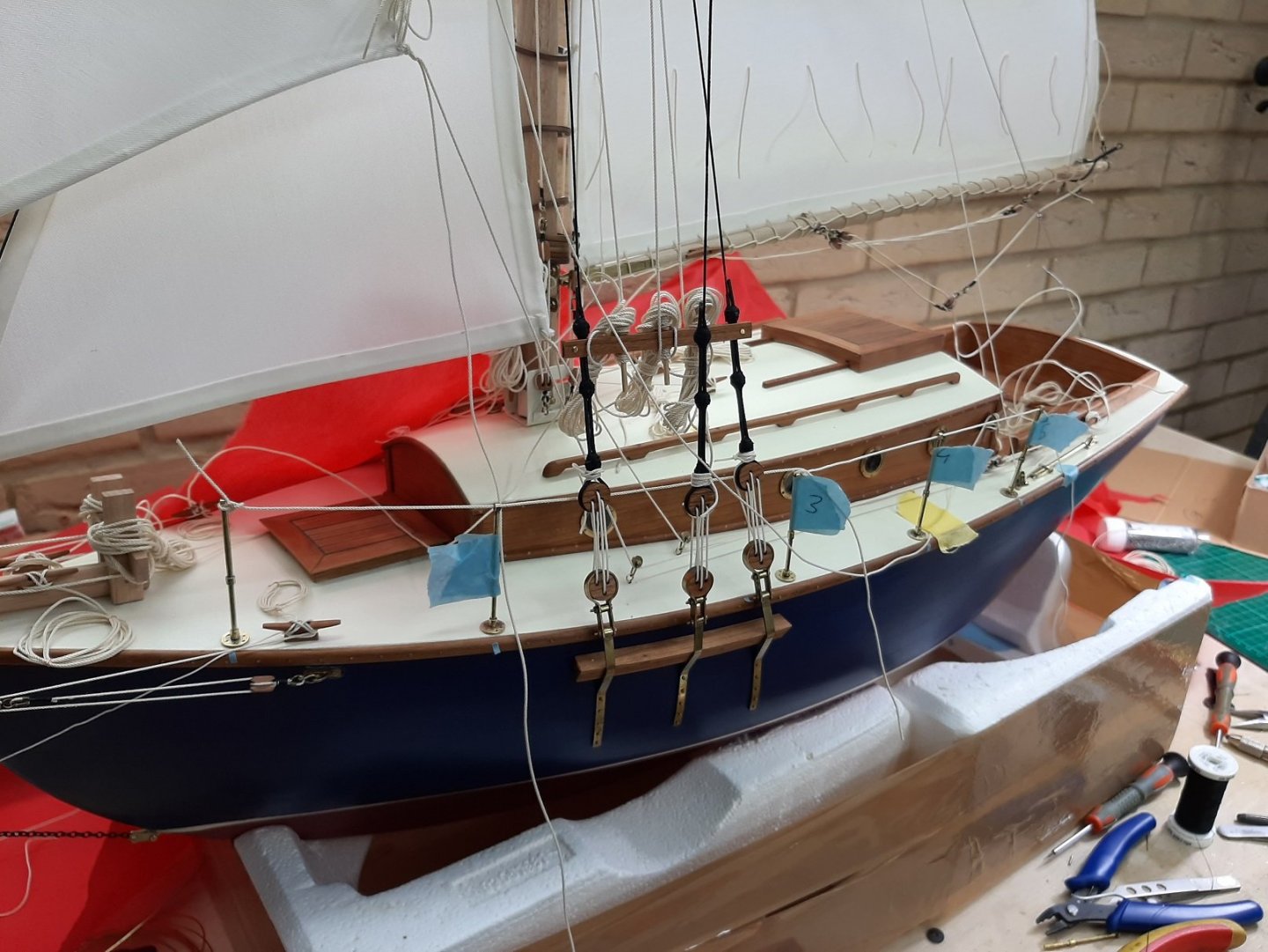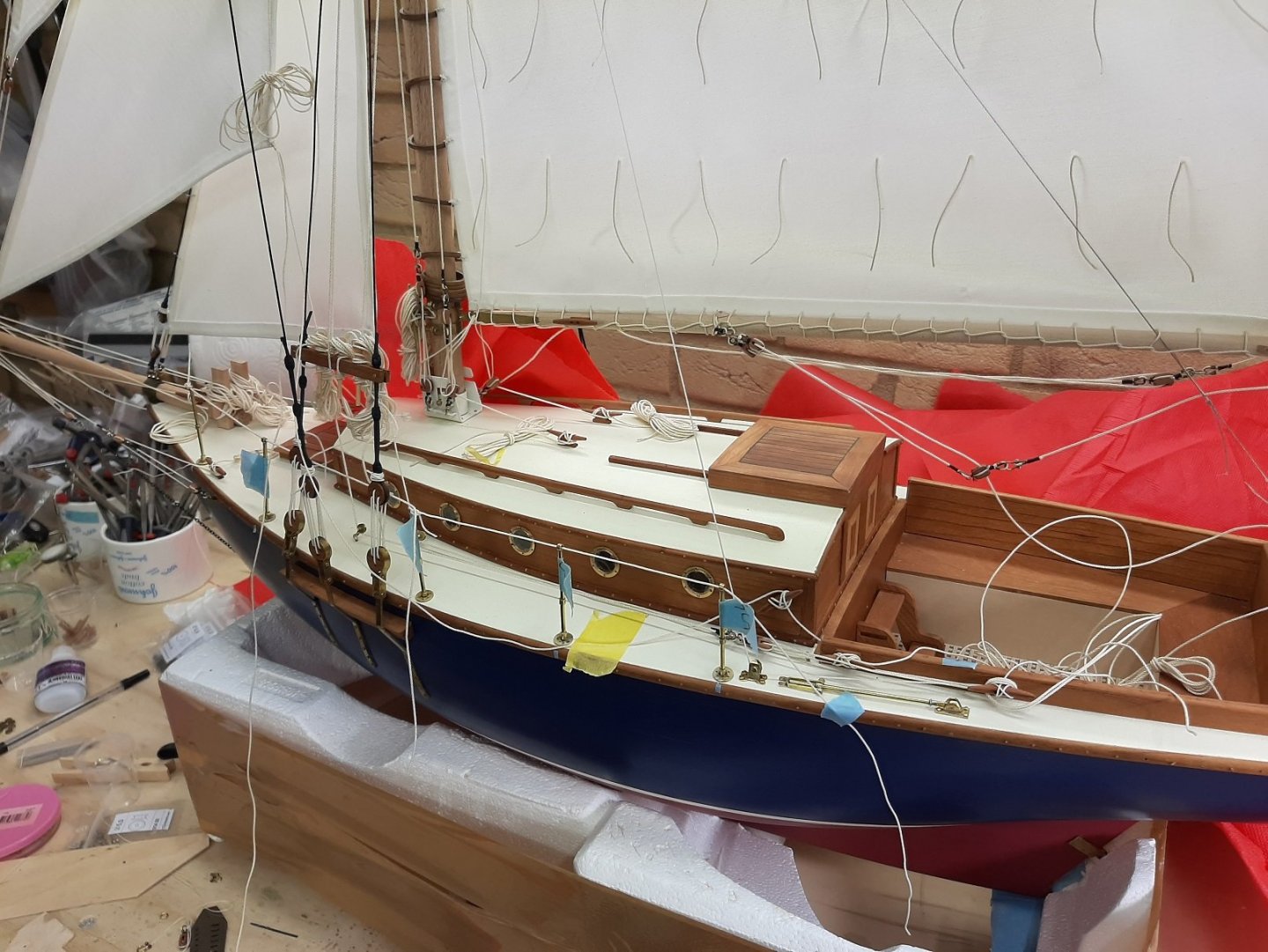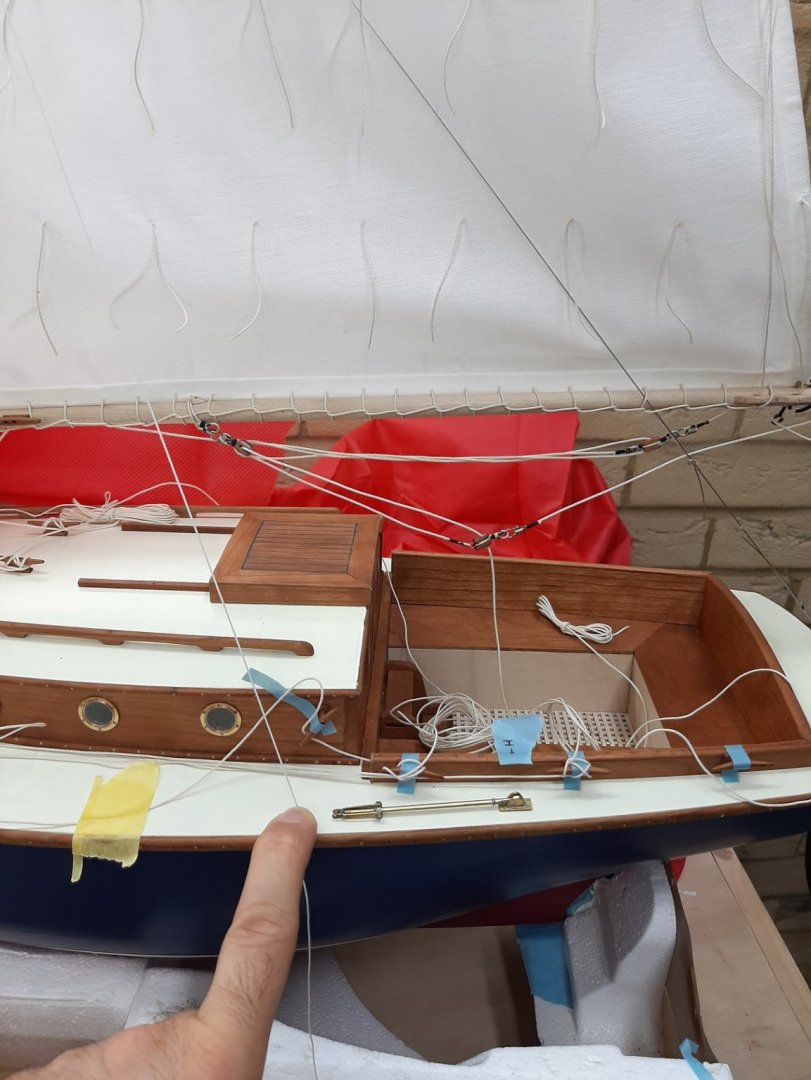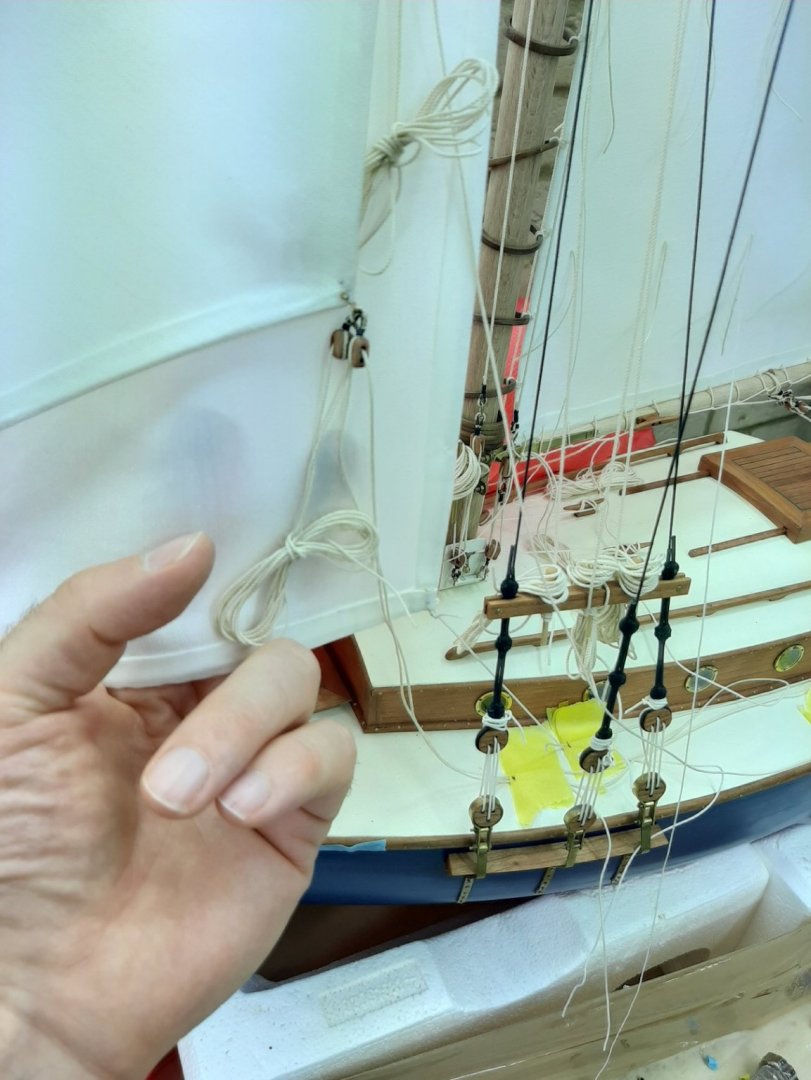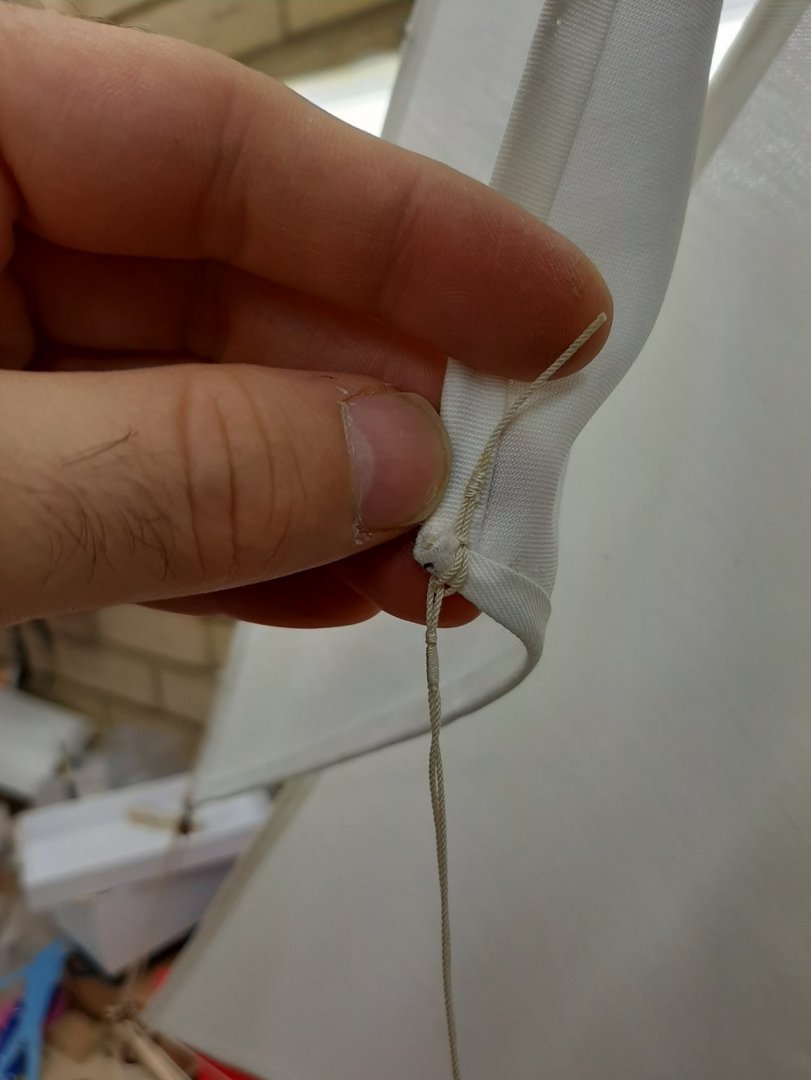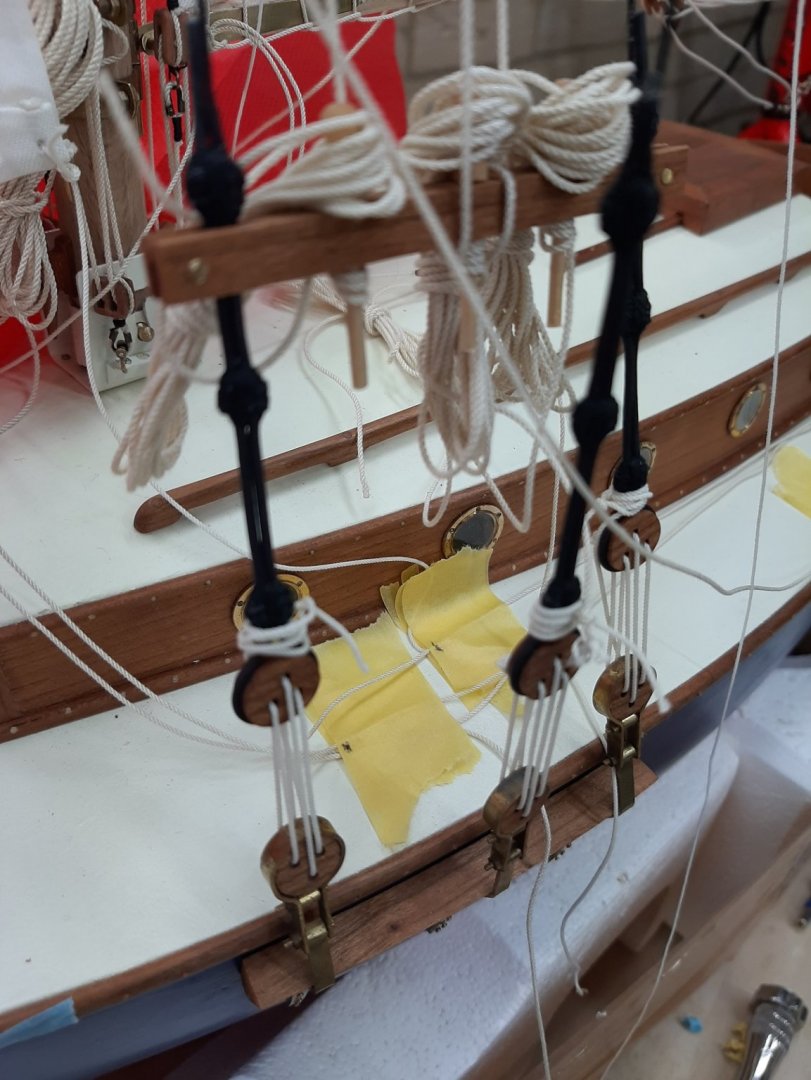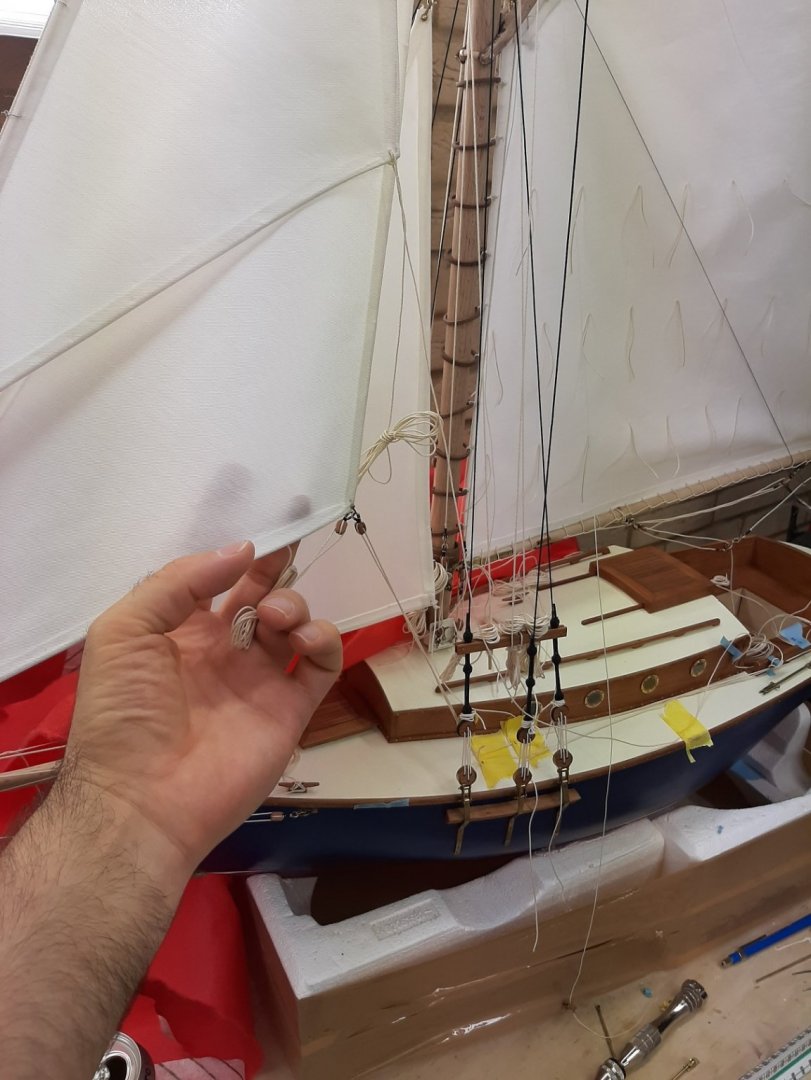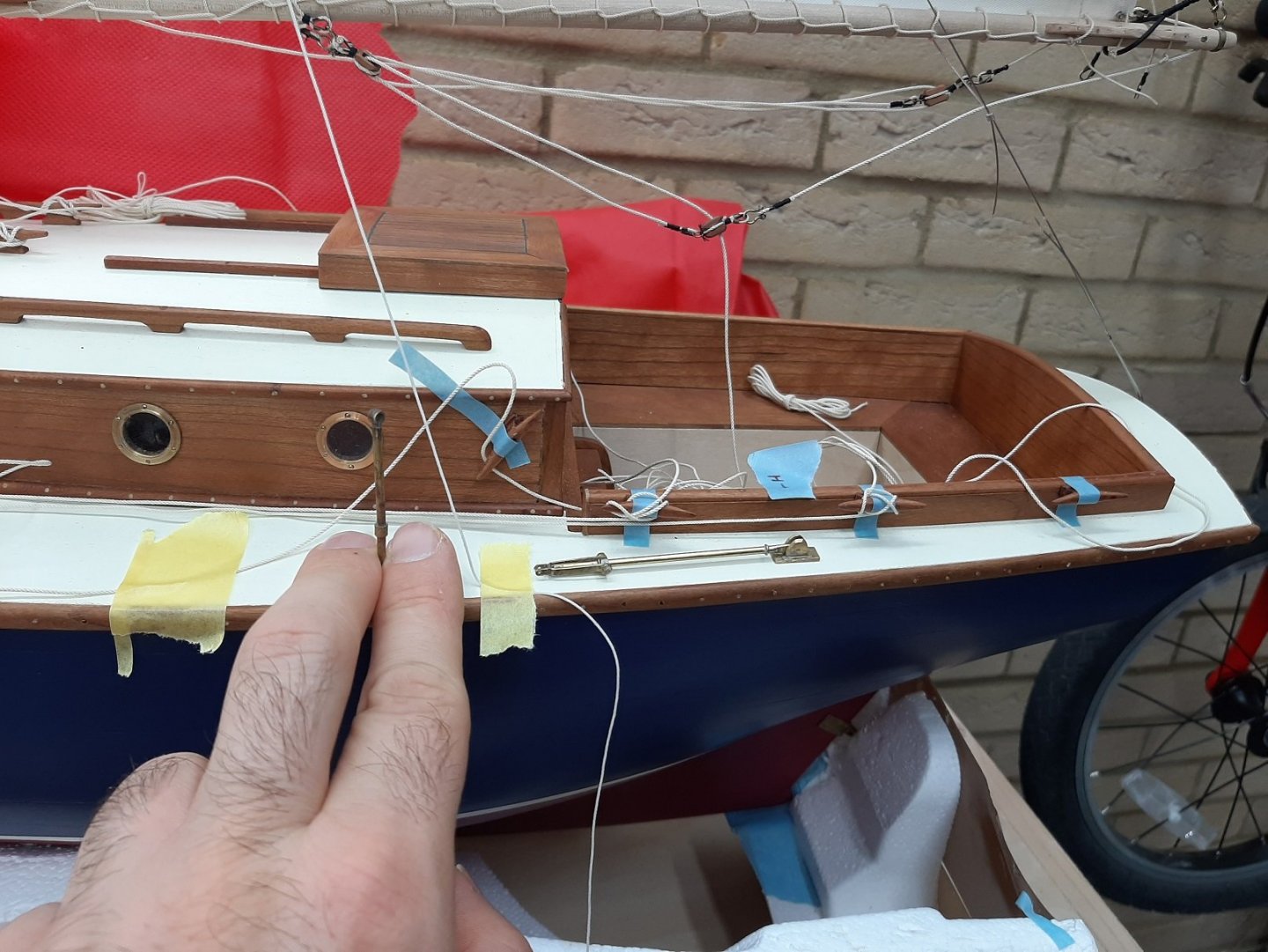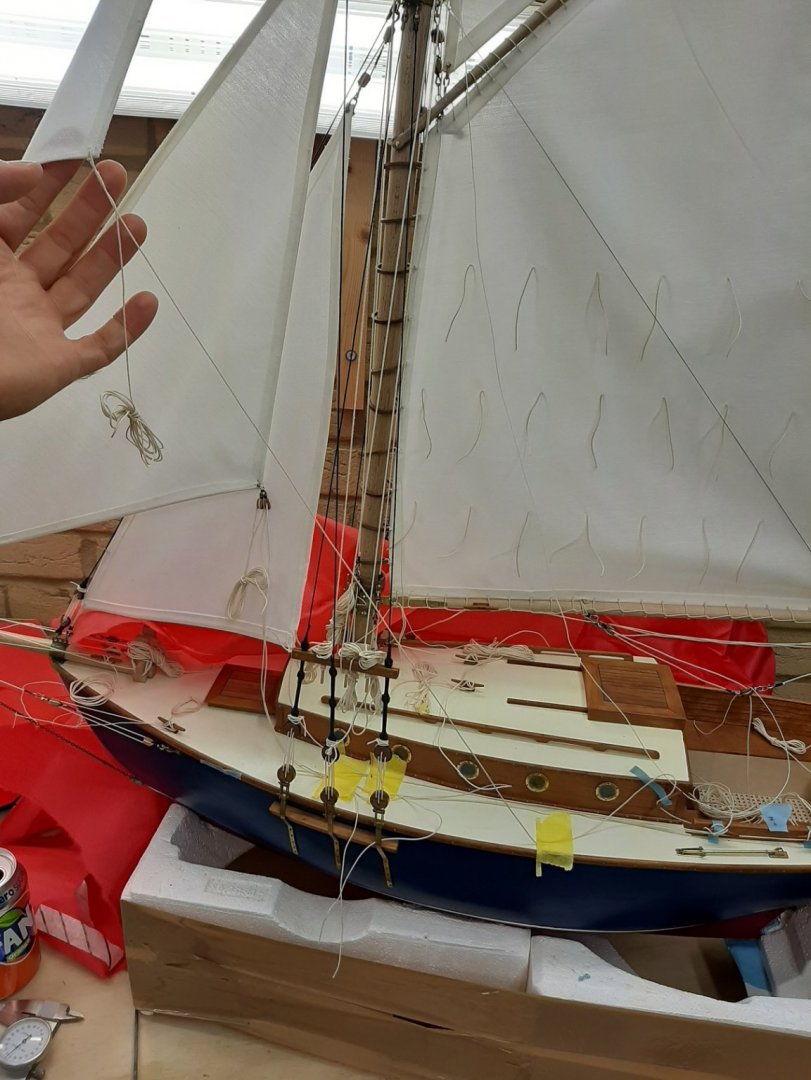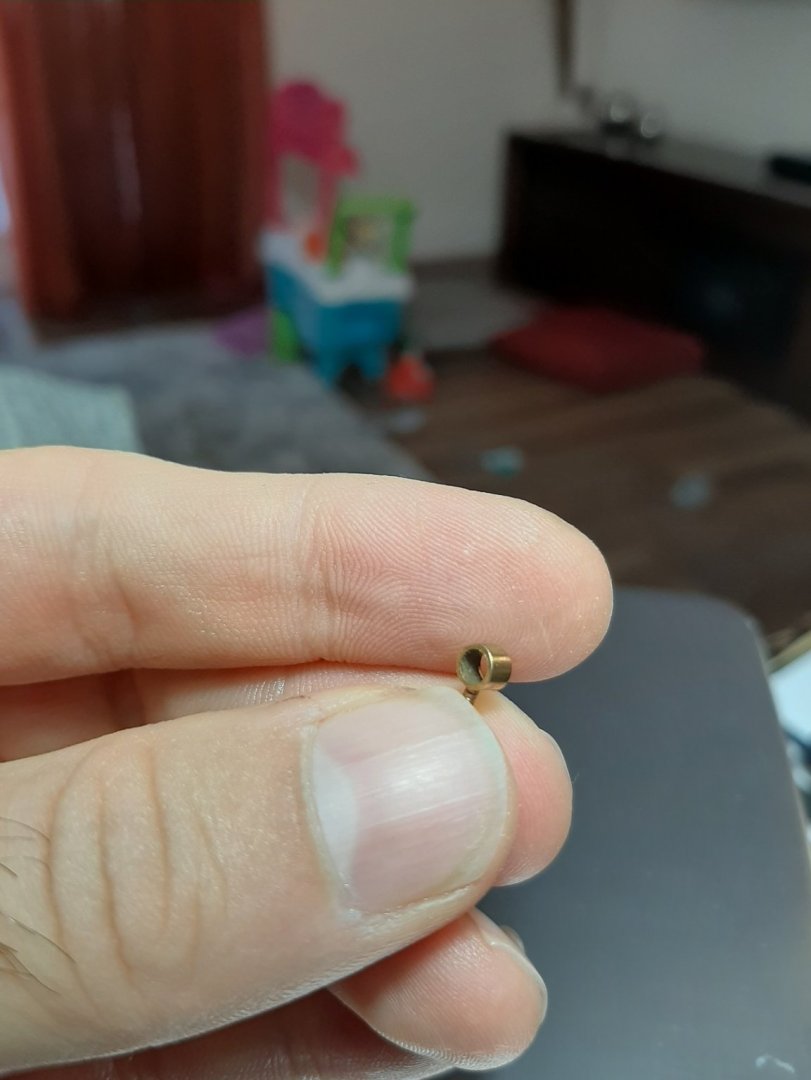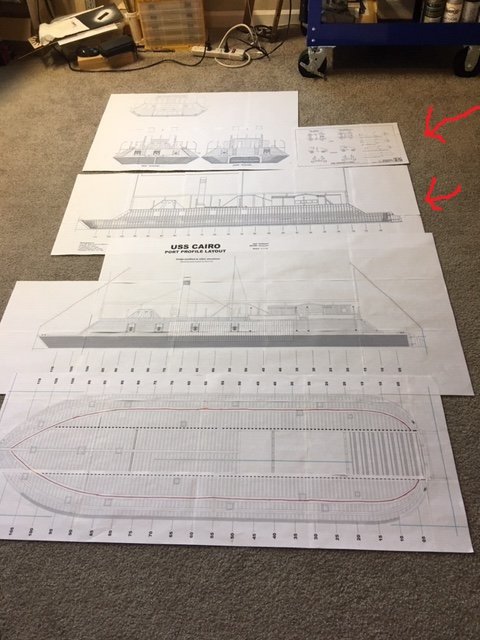-
Posts
1,595 -
Joined
-
Last visited
Content Type
Profiles
Forums
Gallery
Events
Everything posted by vaddoc
-
Thanks Alan! This island is indeed very small! It's been a while since I last crossed the Atlantic and unfortunately I don't think I ll be visiting any time soon.
-
Proper progress today so time for another post! Today was a frightening day. I drilled many massive holes on my deck, no room for failure, no turning back. First of all, I made a number of deck fittings to tie and route lines. I ve been using a lot my new tap and die set so all fittings will be screwed and not glued. I also finally manage to sort out my pickling solution, I had forgotten that hydrogen peroxide is needed so all my brass pieces were coming out pink Now despite using only blocks and not winches, the Deben is a contemporary boat and a really small one. So I thought that some kind of roller/metal sheave would be used for the jib sheets. So I made a few that actually work surprisingly well. Of course, if I change my mind I can simply unscrew and use blocks. I tried a few other designs but unfortunately this is the limit of my metal work. Next photo is the port staysail roller installed. The axle needs trimming I installed a cleat at the side of the cabin and two on the coaming. The top jib will be sheeted without any blocks. The flying jib and stay sail will have a single block but it can easily be changed to any other configuration with more blocks. Then I installed the highfield lever and its sheave. The sheave will face quite a lot of pull so I used proper 1.2 mm brass screws to secure it on the deck. I may change the screws with hex bolts but it is not too important I also drilled 2 mm holes and installed the poles for the rails. This took a lot of head scratching as the rails (which will be ropes going through the poles) need to clear all other lines and components. I think it went well, I still need to drill 6 holes 0.6 mm wide for each pole at the base. Some photos showing the above Everything seems to work together and although cramped, so far I ve found space for everything. The sheet for the top jib I do not think will be a problem. I have a vague idea for the mainsheet and I would like to avoid a traveller. Not far now! I still have no idea what I ll do with the boat when it's finished.
-
Welcome Mike! Do start a log, an Enterprise would be very cool indeed!
-
I this a boat? Is it a plane? Is it the cake my daughters made? Now this is a log I am hooked at. Dying to see where it will lead. GrandpaPhil you certainly brought colour to our days! Lovely.
-
Looks very good indeed, nice painting. The varnish looks a bit more satin than matt? I had a look at your site, your models are fantastic!
- 138 replies
-
- glad tidings
- model shipways
-
(and 1 more)
Tagged with:
-
You are doing a very good job, the boat is coming along nicely, clean and tidy work.
- 44 replies
-
- smuggler
- first build
-
(and 2 more)
Tagged with:
-
You have a very nice hull there, and your deck is coming along nicely.
- 45 replies
-
- j-class yacht
- amati
-
(and 2 more)
Tagged with:
-
So Brian, it seems you are right and that the top view plan is wrong. The planking indeed stops vertical when it meets the rudders and on the other side is the wheel. Somehow the planking continues there.
-
Somethink does not add up. On the side view as well as the photos of the actual boat, the planking reaches the rudders and at that junction the stern appears vertical. On the top view plans though, it is clear that the stern is never vertical. Unless the side planks reach the outside of the rudders vertical but the planking inbetween the two rudders is at a different level and sloped. The side planks seem to indeed stop at the rudders. Apologies if I am over analysing this, I tend to really over engineer and over loft my hulls!
-
Brian, It seems to my that when the hull sides take the turn at the stern, the slope is reduced but it does not get vertical.
-
Thanks Michael, blocks it is then. The end is so close that I am starting to become impatient! To feel like a child is very rare in our ages but it does happen... Some more pictures to explain the progress. I am not sure if they help because my camera is terrible, the boat large and there are ropes everywhere. Anyway, here it goes The two dots are where the sheets will land, the inner for the staysail (inner jib) the other for the flying jib (mid jib). They will not rub. The flying jib in set position The staysail in set position Michael, this is the knot you mentioned, no shackle needed the top jib (outer jib) in set position, landing on deck and tied to a cleat on the side of the cabin However, there are more ropes. The backstays land on deck and need to be clear of other ropes. The highfield levers actually have quite a travel and also need to clear sheets and cleats. This is the optimal position and we are not done yet. There will be a rail, the aft most pole will be round about there and the 2 ropes through the pole will meet the deck somewhere close to the lever, these ropes need to stay clear away of everything else. I need a leap of faith I think and start drilling. Michael (and everyone else), common blocks will do to guide the sheets when they meet the deck or do I need to make some special sheaves/blocks?
-
I think it is time for another post. Michael and Mark, again many thanks for your comments. I ve spent some time thinking about things, searching the net and reading. When I started building this boat, I wanted to make it as complex as I could, so I could learn. But it is still a small 7 m boat so space is very limited. Regarding the main sail, I did not make it very well thus the sag. Lifting the gaff does not correct it, it is not square enough. Now, the lacing, this is a misunderstanding from my side. I was not aware that it is kind of either or, outhaul or laced. I am now committed because the sail is full of holes and the boom full of hardware. I ll just pretend that the boat was built to allow the captain to use both ways and that the mainsail has had so much use that has stretched and needs changing. The sails will be furled either way. Regarding the rest 1. Cleats will be moved to the outside of the coaming, with one cleat added to the side of the cabin 2. The outer jib sheet will course on the outside of the shrouds. Indeed this sail is set very loose so the sheet will not rub on anything. 3. Mark you are very right, Tom Cunliffe I thinks calls blocks on clews "widow makers". Still, looking on photos, many large sail boats use them. In all honesty however, I think for this size boat a simple sheet with no blocks at all should be enough. 4. On the forestay (inner jib) I will reduce the power of the blocks, a 1:1 system should be enough I played around on the boat, trying to arrange the eyes and sheets so that they don't rub. I think it will work but at the stern, everything will be very camped, mainly due to the highfield levers that take on a lot of space and need to move without catching. I tried to tape things and have a complete rigging before I do anything irreversible but it is impossible as strong tape will lift the varnish and low tuck tape cannot hold thing firmly. So I will need to drill and install a few things. I think I will start with the eyes for the sheets of the 3 foresails and also I ll install the cleats. In summary, could I ask for your advice on the following: 1. Is it ok if the flying jib (the middle jib) is sheeted straight without any blocks/purchases? 2. When the sheets reach the deck, do they need to go through a block/sheave or is a simple brass ring/tube like bellow adequate? Regards Vaddoc
-
Brian, could you post a few more photos of the plan, I am trying to understand how the hull works. In your initial photo of the plans, the upper right one and the second row, could you show a close up photo?
-
Bob, it will be interesting to see how many coats you ll need to cover the grey primer. Hand brushing it took me a dozen or so Regarding marking the waterline, this is the method I used. Advantage that you can just wipe it clean and start over. https://modelshipworld.com/topic/18455-another-way-to-mark-the-waterline/?tab=comments#comment-567858
-
If it wasn't for the rudders, I d say that the stern is only vertical at the midline, and gets a gradually steeper slope as it extends sideways. Maybe I am completely wrong though, difficult to orient on the photo of the plans
-
This is very interesting. I must admit it is not easy to visualise how the ship will take shape but it is indeed fascinating to follow
-
Looking very good Kevin. I really like this boat. Mahogany is not only difficult to work with, it is very difficult to finish. I remember with a mahogany deck I struggled a lot, then after a few years the red colour has faded and is almost brown.
-
.thumb.jpg.6fd4c1b78768bb3efd745ab810936005.jpg)
Being a newbie
vaddoc replied to Edwardkenway's topic in Using the MSW forum - **NO MODELING CONTENT IN THIS SUB-FORUM**
What a wonderful way to describe modelling! These last few weeks I seem to spend more time on my knees looking for pieces on the floor than on my stool. -
.thumb.jpg.6fd4c1b78768bb3efd745ab810936005.jpg)
Change Theme
vaddoc replied to cog's topic in Using the MSW forum - **NO MODELING CONTENT IN THIS SUB-FORUM**
Sure, no problem!
About us
Modelshipworld - Advancing Ship Modeling through Research
SSL Secured
Your security is important for us so this Website is SSL-Secured
NRG Mailing Address
Nautical Research Guild
237 South Lincoln Street
Westmont IL, 60559-1917
Model Ship World ® and the MSW logo are Registered Trademarks, and belong to the Nautical Research Guild (United States Patent and Trademark Office: No. 6,929,264 & No. 6,929,274, registered Dec. 20, 2022)
Helpful Links
About the NRG
If you enjoy building ship models that are historically accurate as well as beautiful, then The Nautical Research Guild (NRG) is just right for you.
The Guild is a non-profit educational organization whose mission is to “Advance Ship Modeling Through Research”. We provide support to our members in their efforts to raise the quality of their model ships.
The Nautical Research Guild has published our world-renowned quarterly magazine, The Nautical Research Journal, since 1955. The pages of the Journal are full of articles by accomplished ship modelers who show you how they create those exquisite details on their models, and by maritime historians who show you the correct details to build. The Journal is available in both print and digital editions. Go to the NRG web site (www.thenrg.org) to download a complimentary digital copy of the Journal. The NRG also publishes plan sets, books and compilations of back issues of the Journal and the former Ships in Scale and Model Ship Builder magazines.



